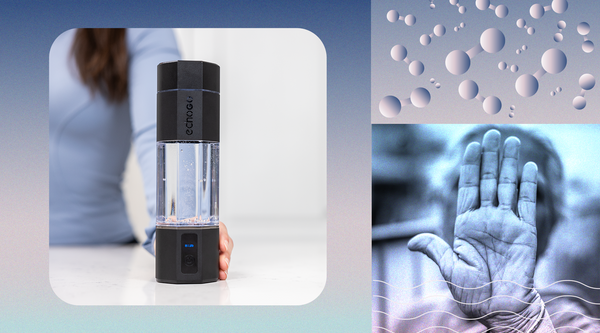We all know normal water consists of two hydrogen molecules and one oxygen molecule. We also know that hydrogen-enriched water is normal water with a higher concentration of hydrogen gas dissolved in it. But you may not know how hydrogen-enriched water gets the extra PPM of hydrogen gas molecules.

One of the most widely used methods for creating hydrogen water is electrolysis. Electrolysis is a process that uses electricity to break down water molecules (H2O) into its basic building blocks: hydrogen (H2) and oxygen (O2). And in electrolysis, PEM membranes play a starring role by acting as a conductor and a separator, all in one thin film.
But before we get ahead of ourselves, let’s talk about what a PEM membrane is.
What is a PEM Membrane?
A PEM (Proton Exchange Membrane), or polymer electrolyte membrane, is a thin film with special properties. Here are the key characteristics of a PEM membrane:
- Semipermeable: Allows certain things to pass through while blocking others.
- Proton conductor: Specifically designed to conduct protons (H+ ions).
- Electrical insulator: Prevents electrons from flowing freely through the membrane.
- Reactant barrier: Separates different chemical reactions happening on either side of the membrane.
How Do PEM Membranes Work in the Hydrogen Enrichment Process?
PEM membranes are a key component in devices that generate hydrogen-enriched water called electrolyzers. According to the Office of Energy Efficiency & Renewable Energy, this is how the PEM membrane works in the electrolysis process:
- “Water reacts at the anode to form oxygen and positively charged hydrogen ions (protons).
- The electrons flow through an external circuit and the hydrogen ions selectively move across the PEM to the cathode.
At the cathode, hydrogen ions combine with electrons from the external circuit to form hydrogen gas. Anode Reaction: 2H2O → O2 + 4H+ + 4e- Cathode Reaction: 4H+ + 4e- → 2H2”
If that made no sense to you, you’re not alone. So, let’s take the process step-by-step …
Step 1: Solid Electrolyte: Instead of a liquid like battery acid, an electrolyzer uses a special kind of thin, plastic film called a PEM. It acts like a gatekeeper, allowing certain things to pass through while blocking others.
Step 2: Splitting Water: You put water into the machine. Inside the electrolyzer, there’s a positive side (anode) and a negative side (cathode). A PEM sits between them and acts like a picky traffic cop. At the anode, electricity breaks the water molecules apart. This creates two things: oxygen gas and tiny positive particles called protons (H+).
Step 3: Proton Highway: The PEM acts like a special highway for these protons. It allows only protons (H+) from the split water molecules to pass through the membrane, but blocks the oxygen gas from going the other way. Electrons, on the other hand, are blocked by the PEM. Think of it like a one-way toll booth for protons.
Step 4: Electron Path: While the protons take the PEM shortcut, the electrons created from splitting the water can't go through the membrane. Instead, they travel through an external wire, creating an electric current (like in a battery).
This separation is crucial because electrons need to flow freely to complete the electrical circuit. If they went through the PEM, they’d directly combine with protons on the other side, cancelling out the whole splitting process.
Step 5: Hydrogen Gas Reunion: On the other side of the PEM (the cathode), the protons are reunited with the electrons that traveled through the wire. This happy reunion creates clean hydrogen gas (H2), which is then dissolved back into the water.
Meanwhile, the oxygen gas produced at the anode is kept separate by the PEM. It is then safely vented into the outside air.
PEM Membranes Simplified
When it comes down to it, this is what you need to know about PEM membranes and their role in creating hydrogen-enriched water:
Electrolysis splits water, and PEM membranes within the device act as a gatekeeper, separating protons for hydrogen production (and potential enrichment) while keeping oxygen and electrons on separate paths. This separation allows the technology to focus on creating an environment for more hydrogen to be present in the water.
Essentially, PEM membranes are the reason electrolyzers can create hydrogen-enriched water. Without the PEM membrane, we’d all just be drinking normal water without the added antioxidant benefits of hydrogen water in our diets.
If you’d like to watch the electrolysis process in action and reap the benefits of PEM membranes, get your own hydrogen water bottle or pitcher today.








